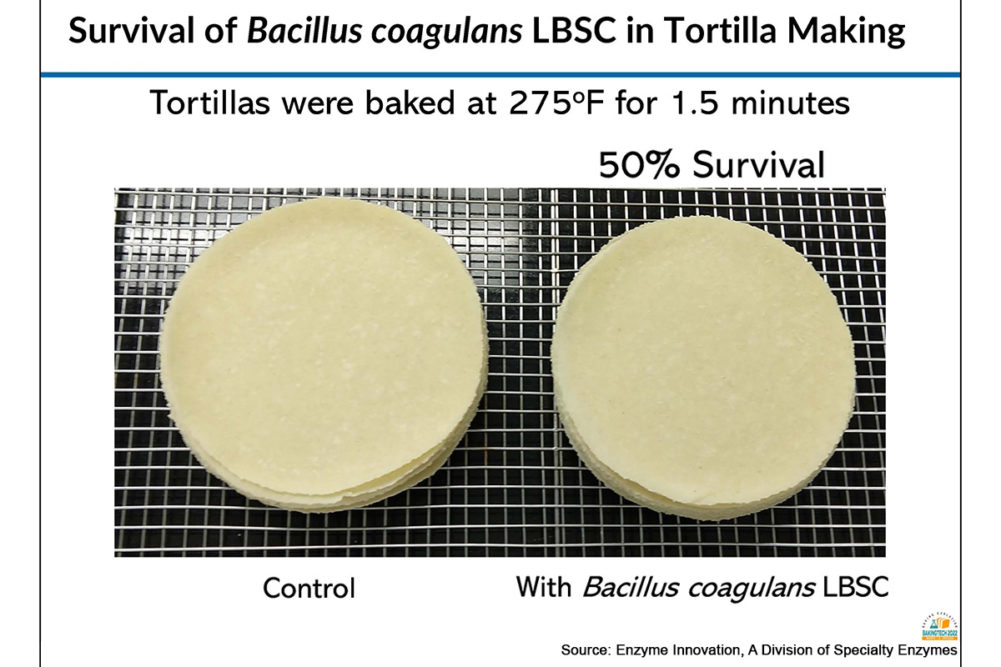CHICAGO — Sophia Leung sees the potential of probiotics in baked foods within her own household.
“It’s a lot more appealing to have probiotics in something like a muffin than probiotic supplements, or as my husband calls them, ‘those awful, horse-sized pills,’” she said March 3 during her presentation at the American Society of Baking’s BakingTech in Chicago. “Baked foods also can add a lot of variety to the traditional dietary supplements and also the typical yogurt product.”
Ms. Leung, a food science lab manager at Enzyme Innovation, a division of Specialty Enzymes and Probiotics, gave details on how spore-forming probiotics, because of their survival rates in high-heat processing, are the best options for baked foods.
Growing consumer interest in probiotics was evident in a forecast from Grand View Research, San Francisco, showing the global probiotics market will have a compound annual growth rate of 7.5% from 2021 to 2030, reaching a size of $112.21 billion. Probiotics balance gut bacteria, limit colonization of pathogens and are important for digestive enzymes, Ms. Leung said. Research has shown that probiotics, besides providing digestive benefits, also may improve mood, alleviate stress and improve sleep, she said.
The Food and Agriculture Organization of the United Nations and the World Health Organization define probiotics as “live microorganisms, which, when administered in adequate amounts, confer a health benefit on the host.” Probiotics must survive and reach the site of action, must prove to be beneficial for the host and must be stable during processing.
Probiotic strains in the Bifidobacterium genus and the Lactobacillus genus often are used in food applications, but they do not work as well in baked foods since they do not form spores and thus fare poorly in high-heat conditions, Ms. Leung said.
“Even if you add these probiotics after baking and you refrigerate the baked goods, these probiotics, they can make lactic acid, and they potentially can cause changes in flavor of the product during storage, possibly even a vinegar-like taste,” she said.
Probiotic strains in the Bacillus genus are spore-forming. Common species include Bacillus coagulans, Bacillus clausii and Bacillus subtilis. Spore-forming probiotics work in a wide temperature and pH range, and they do not require refrigeration, Ms. Leung said. They are shelf-stable, heat-stable and have high survival rates. They stay dormant, or hibernate, during the baking process.
“When (the spores) reach favorable conditions like our gut, they convert back to vegetative cells, and they are activated,” she said. “So they help us with health benefits.”
Lab work from Advanced Enzyme Technologies Ltd. in India analyzed the potency of Bacillus coagulans LBSC in post-food preparation. The percentage of potency was over 60% in muffins, nearly 90% in cookies and nearly 100% in instant noodles. Enzyme Innovation in its research baked tortillas at 275 degrees Fahrenheit for 1.5 minutes. The survival rate for the Bacillus coagulans LBSC was 50%. The survival rate will affect the number of probiotics added to applications.
“You want to make sure after you process it at the end of the shelf life, you’re still going to have that targeted amount,” Ms. Leung said.
Before choosing probiotic strains, baked foods companies should determine what health claims to target and what the process/storage conditions will be. Companies could promote the product for containing probiotics or for containing a specific amount of probiotics, or they could make a health claim.
“If you want that health claim, you really want clinical research to back it up,” Ms. Leung said.
Enzyme Innovation recommends adding the probiotics during mixing.
“You get a much more even distribution,” Ms. Leung said. “If it’s for bread, you can also add it at the moulding step with your dusting flour. The challenge with that is it might be harder to apply evenly.”
Probiotics also may be applied post-baking, such as in spray, frosting or filling.
“The advantage here is you are going to avoid the high heat,” Ms. Leung said. “You might be able to use less probiotics.”
Probiotics are harder to apply evenly post-baking, and spray may bring added costs, she added.





